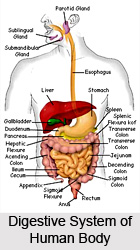 Yoga Asanas often target the abdominal muscle and the diaphragm, and thereby have a strong beneficial impact on the digestive system. This is especially true of those asanas classified as cultural.
Yoga Asanas often target the abdominal muscle and the diaphragm, and thereby have a strong beneficial impact on the digestive system. This is especially true of those asanas classified as cultural.
The compression of the diaphragm and the abdominal walls provide massage to the abdominal contents that are immensely useful in gastric conditions. It is excellent for those people suffering from indigestion, constipation, acidity, excess wind or gas, lack of appetite, diameter, disorders of the male reproductive systems and varicose veins. It also eliminates energy blockage in the abdominal areas. When too much junk and stale food is consumed along with excessive mental stress, the digestive system is greatly affected and these Yoga asanas are very beneficial.
The digestive tract of the human body is also known as the alimentary canal. It is the system of organs that takes in food, digests it to extract energy and nutrients, and expels the remaining waste. The major function of the digestive tract is ingestion, digestion, absorption, and defecation. The digestive tract is approximately 6.5 meters (20 feet) long and consists of the upper and lower tracts.
Only a small part of it is situated in the chest, most of the tube being held in the abdomen. The part next to the mouth is the pharynx which descends down the throat and ends in the esophagus or the gullet. Passing behind the trachea the esophagus crosses the chest almost vertically, till it pierces the diaphragm and enters the abdomen. The esophagus is about 9 inches in length. After coming into the abdomen in the form of the esophagus, the digestive tube becomes greatly dilated to form the stomach. So the stomach is only a dilated part of the alimentary canal. The stomach is curved and the inner wall is the lesser curve and the outer is the greater curve. The stomach lies just below the diaphragm and crosses the abdomen from left to right. It ends in the small intestine. The stomach has two openings. The upper opening connects it with the esophagus and the lower one joins it with the small intestine. Both these openings are formed of strong muscular rings which remain closed usually, but which open when necessary. The upper opening is called the cardiac orifice and the lower one the pyloric orifice.
 The small intestine is small in calibre and its whole length is held inside the abdomen in several coils. The small intestine is divided into three parts, these successive parts being named as the duodenum, the jejunum and the ileum. The ileum opens into the large intestine or the colon by means of a valve called the ileo-cecal valve. The colon is called the large intestine because of its big calibre and its length is only 5 feet. In the abdomen it passes in a curve round the coils of the small intestine and gets different names for its different parts. The part of it, which is below the ileo-cecal valve, is called the cecum. To this cecum, a small organ called the appendix is attached. This organ when inflamed gives rise to the disease appendicitis.
The small intestine is small in calibre and its whole length is held inside the abdomen in several coils. The small intestine is divided into three parts, these successive parts being named as the duodenum, the jejunum and the ileum. The ileum opens into the large intestine or the colon by means of a valve called the ileo-cecal valve. The colon is called the large intestine because of its big calibre and its length is only 5 feet. In the abdomen it passes in a curve round the coils of the small intestine and gets different names for its different parts. The part of it, which is below the ileo-cecal valve, is called the cecum. To this cecum, a small organ called the appendix is attached. This organ when inflamed gives rise to the disease appendicitis.
Yoga asanas create movements in the human body that greatly enhance the activities of the digestive organs. There are several ailments that occur in the digestive tract due to various reasons. Bowel irregularities can be caused due to an unhealthy lifestyle, consuming the wrong kinds of foods, chronic indigestion, and an extra sensitive digestive system. One should avoid foods that cause bowel disorders. Digestive system works best if fresh foods such as vegetables, salads, fruits, curd and buttermilk are consumed at a regular basis. Besides this yoga asanas are the best possible ways to treat the digestive ailments naturally.
Jathara Parivartanaasana or the `Revolved Abdominal Pose` is truly beneficial for the internal organs and to relieve the stiffness in the back. It also helps to get rid of excess fats, tones the liver, pancreas and spleen. It boosts the strength of the intestines and also helps to keep the abdominal organs healthy. Apanaasana or the `Knees to Chest` pose helps to keep the digestive system healthy and improves the elimination of wastes. Uttanasana or `standing forward bend asana` helps to alleviate depression and stress. It also has a stimulating effect on the kidneys and liver and improves the functions of the digestive system. If a person frequently suffers from bloating, cramping, and gas after meals, one should practice the Bhujangasana and Pavan Muktasana regularly.
Yoga asanas increase blood flow to the digestive tract and stimulate the intestinal action known as peristalsis that results in digestion more efficiently. Yoga also calms the mind, which in turn relaxes the digestive system and leads to more effective elimination. Forward bend asanas increase the space in the abdomen and facilitate the release of entrapped gases. Yoga asanas are highly beneficial to the proper functioning of the nervous system if performed properly.




















